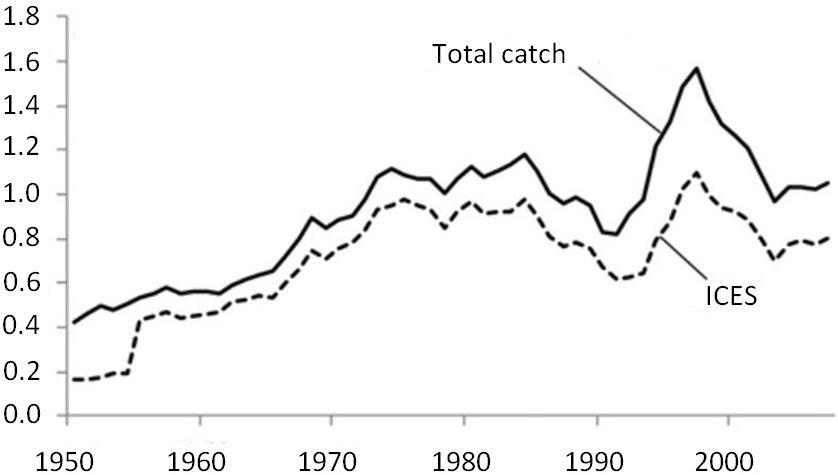History of Catches in the Baltic Sea
Ancient History of the Use of Baltic Fish
Fishing in the Baltic Sea has a very long history dating back to the Stone Age. Archaeological records show that fishing was conducted along the Baltic coast since well before the Middle Ages. Food caught from the sea was an essential complement to game for people who settled on the shores of the Baltic soon after the ice had retreated. At present numerous museums around the Baltic present how hunter-gatherers were able to catch fish with different gear close to shoreline and river-mouths as river spawning fish returned to their spawning grounds. The earliest fishing took place near the coasts and on the islands as settlements spread. Navigation developed along with boat building skills. Analyses carried out of early dwelling sites suggest that fish catches consisted of littoral species such as pike, perch, ide and bream together with river spawning species such as salmon and trout.
Baltic Fish Paid as Levies and Taxes
Fishing was clearly an important economic and social activity in the Baltic Sea region since at least the 1500s. Its importance is seen in the decision and commitment of local authorities to levy taxes on the most profitable fisheries. Indeed in many instances the taxes were paid in fish, rather than other forms of compensation.
Cod Fishery
The Baltic Sea cod fishery has an ancient history. Cod bones have been found in archaeological studies on Bornholm and other coastal areas along the Baltic. These findings are from the 6th-7th and 11th centuries AD. Cod has for long been an important and valuable fish in the Baltic Sea. Cod taxes (i.e. taxes paid as cod) have been levied since at least the 1400s-1500s. The tax accounts of Bornholm and Blekinge 1580-1658 document a large sized cod fishery, which took place at the coast of Blekinge. The Danish Crown had a preferential claim on the shore fishery. The custom accounts of Bornholm 1663-1898 and the main export ports of Sealand 1843-1900 include salted, smoked and fresh fish exported from the island. Live cod from Bornholm was brought to the markets in the capital Copenhagen.
Baltic Herring
Herring fishery in the Baltic developed in the days of the Hansa League. Back then herring was an important commodity for trade with southern Europe. Quantifiable herring fisheries have existed at least since the late 1500s in the southern Baltic (present-day southern Sweden) when herring fishermen were obliged to pay taxes in herring for a permission to fish. Private manor owners in Estonia captured herring in the late 1600s and maintained records of landings. Herring fishing continued into the 1700s and later in Danish/Swedish provinces in the southern Baltic.
Salmonids and Sturgeons
Salmon and sea trout were important fish species caught in river mouths of the northern Baltic Sea. The Swedish Crown had legal rights of salmon and preferential claim on the fishery e.g. in Kalix-, Torneå- Kemi- and Oulu -rivers. Fish products were actively exchanged between towns and countries stretching throughout and beyond the Baltic. Sturgeons, once common and important in the Baltic Sea and its large rivers, are now extinct from the area.
Modern Society Spoils Fish and Cuts Fishing Opportunities
After the Second World War the rapid development of industrialization and new settlements surrounding the Baltic Sea have had a major influence on Baltic fish species, habitats and fishing opportunities. Pollution and eutrophication have caused destruction of habitats of the species in littoral areas all over the Baltic Sea and led to reductions in the reproductive success of many fish populations. In general, eutrophication increases fisheries production but reduces biodiversity.
The construction of hydroelectric power stations, reservoirs and regulations in the main Baltic watercourses from the 1940s until the 1960s impaired the natural reproduction of migratory fish species like salmon, sea trout, migratory whitefish and eel. As a consequence, the natural populations and thus fisheries of these species have decreased substantially.
Time Between 1950s and 1990s
Between 1950 and 1970 new fishing methods and techniques – new nylon net materials, open sea fisheries and trawling – were developed and Baltic fish catches increased rapidly. The Baltic cod catches peaked in the middle of the 1980s following a collapse of the stock causing economic problems for small fishing communities and for the fish refining industry in the southern Baltic countries during 1990s. Between 1970 and the 1990s the salmon driftnet fishery as well as long lines and hooks were developed. Total fisheries removals in the Baltic Sea for the period of 1950-2007 are illustrated in the figure below.

Fisheries removals by all nine countries fishing in the Baltic Sea for the period 1950–2007. Total removals (solid line) and landings reported to the ICES landings statistics (dashed line). Source: D. Zeller et al. 2011.1
Development of industrial fishing
The number and size of trawlers increased gradually in the Baltic Sea. More effective vessels with various trawling techniques led to less laborious and cost-effective fisheries. Evacuation pumps, sorting machines, refrigeration units and filleting machines eased handling and transportation of catch. The number of Baltic fishing vessels and professional fishermen has continuously been decreasing since the 1990s, yet the fish catches as bigger as ever before due to bigger and more effective trawlers, tankers and gear.
1D. Zeller, P. Rossing, S. Harper, L. Persson, S. Booth, D. Pauly 2011. The Baltic Sea: Estimates of total fisheries removals 1950–2007. —Fisheries Research 108: 356–363.
